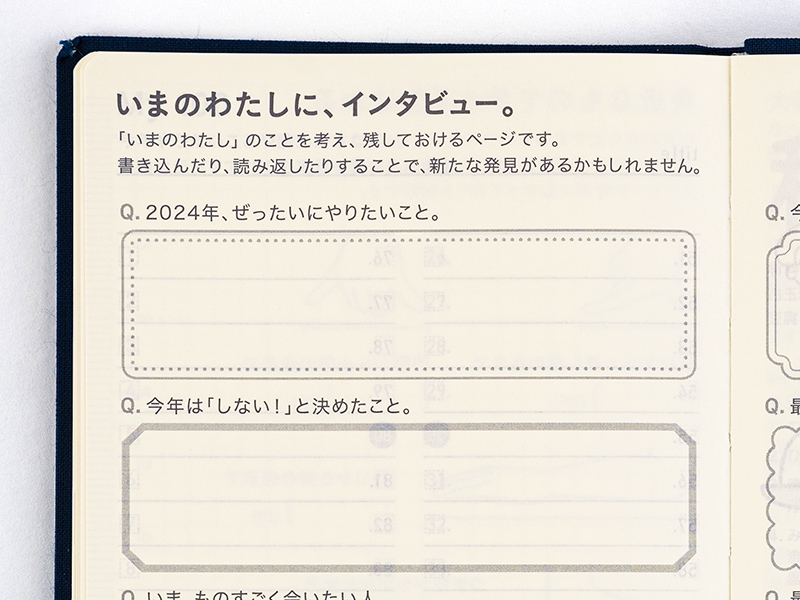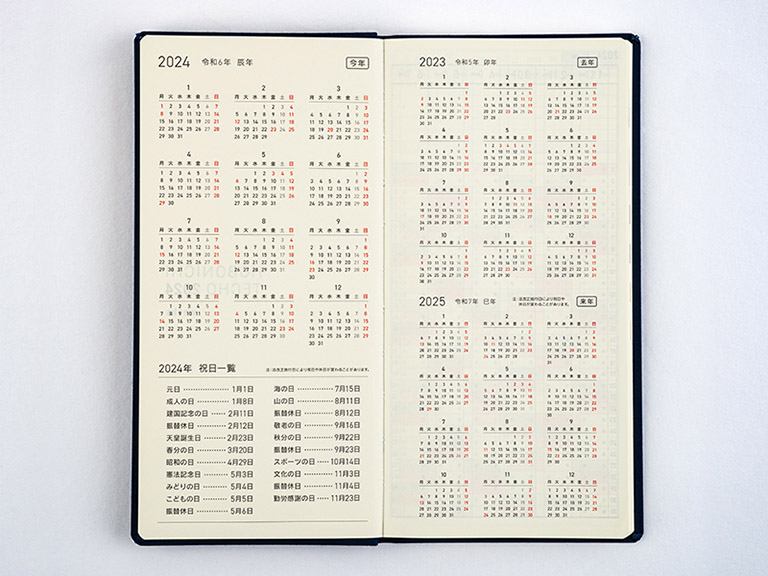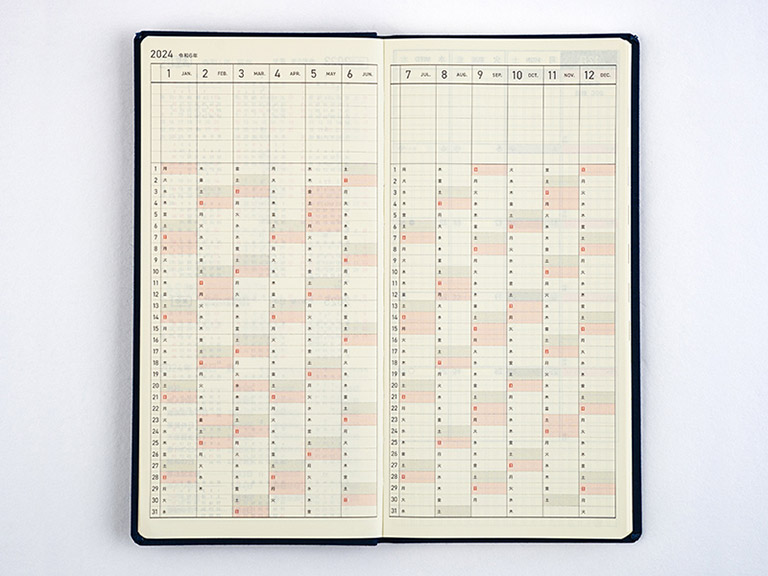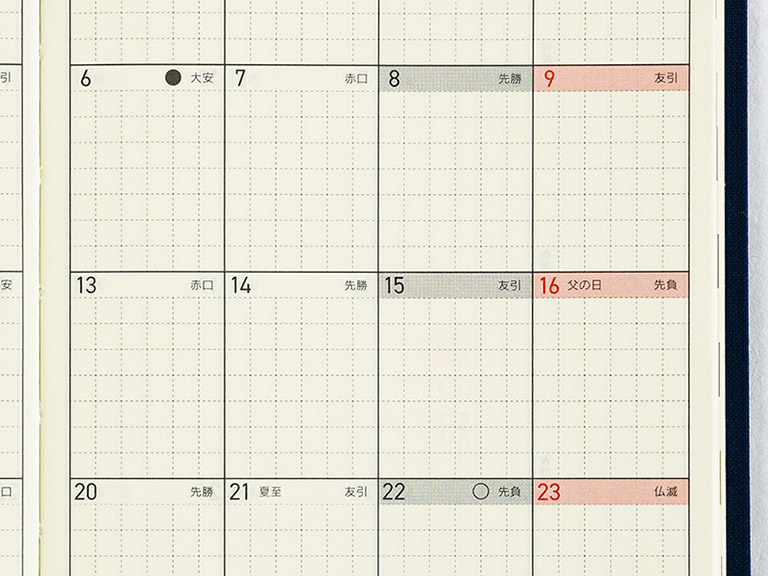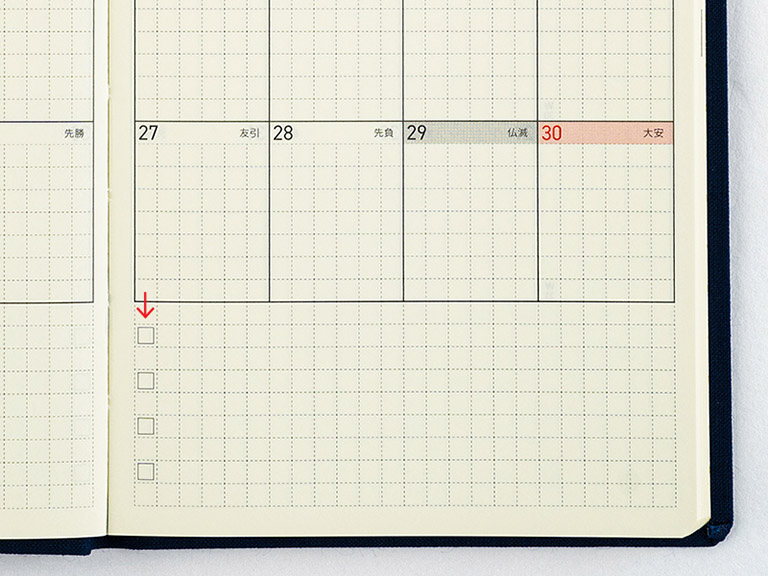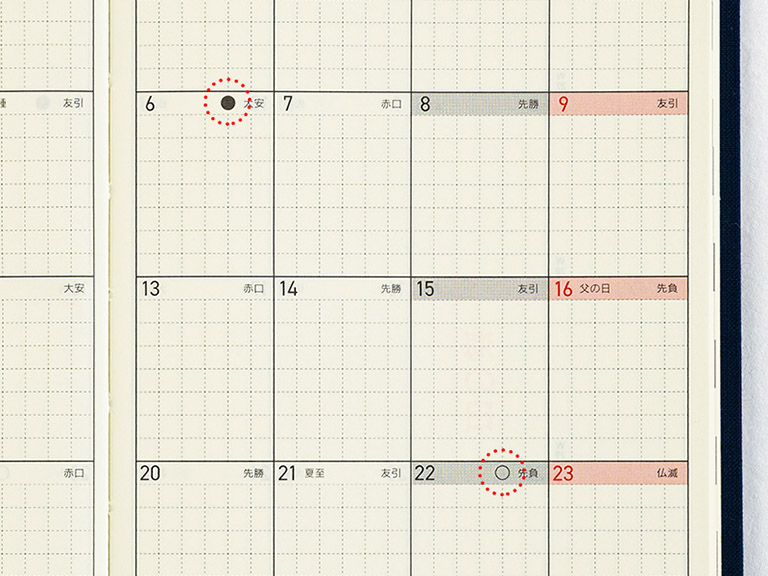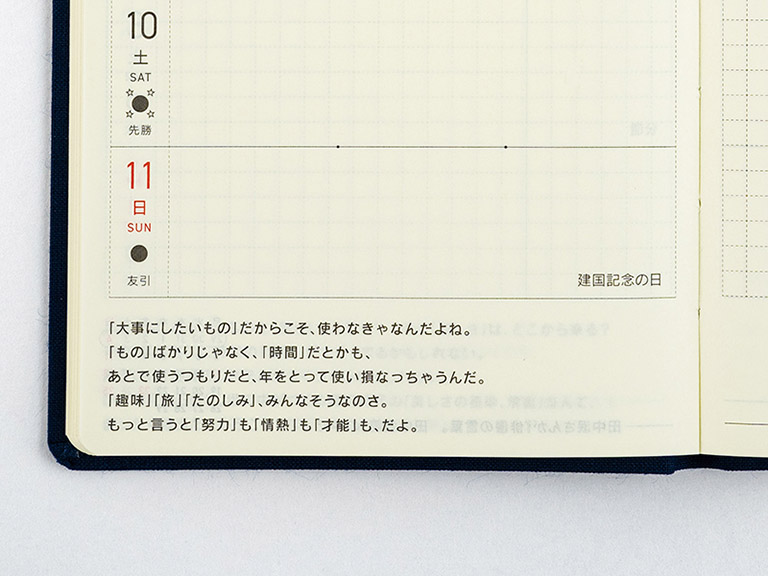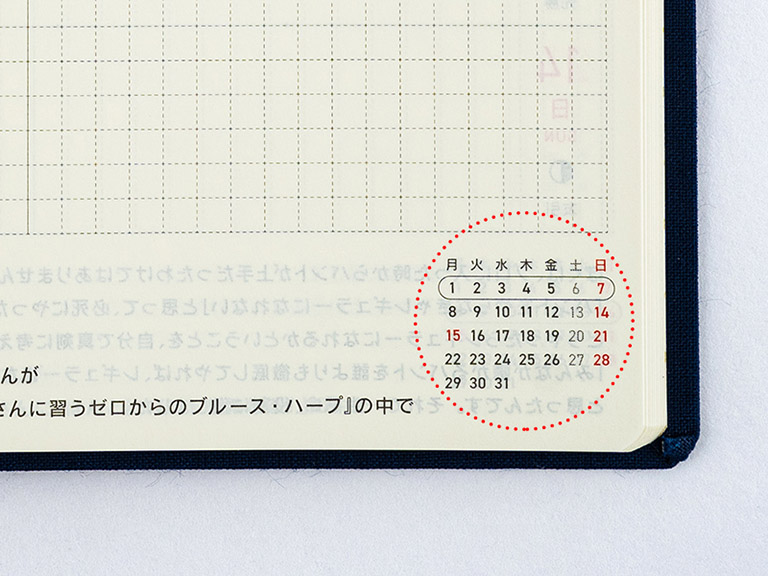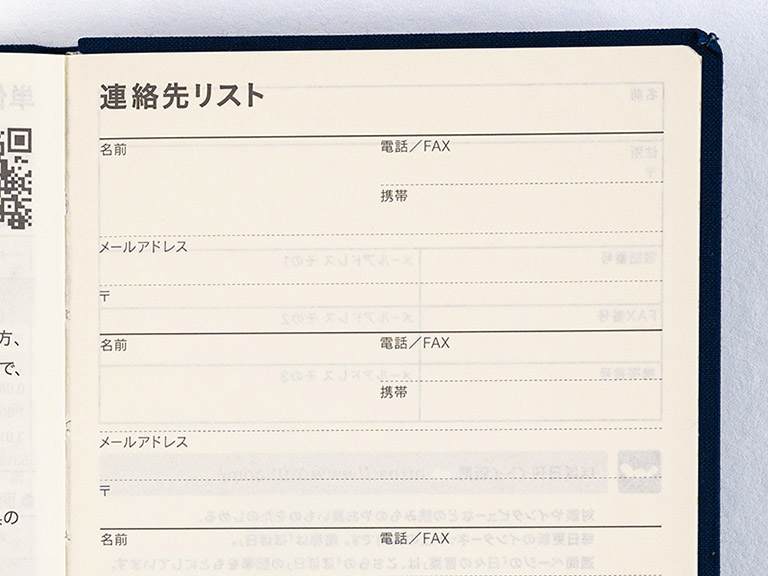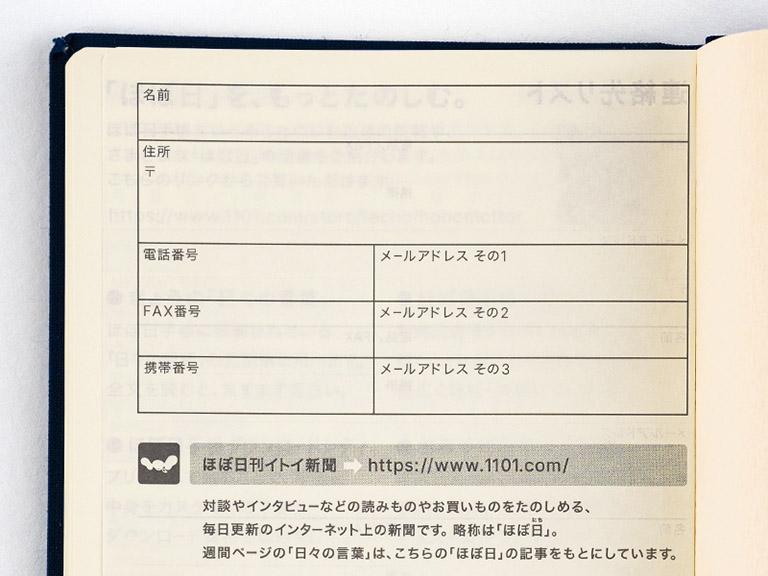HOBONICHI TECHO 2024 Book Buying Guide Weeks Tall and slim
- Japanese
- English
- Simplified Chinese
- Weeks Mega
- Compact and slim
- Weekly calendar on the left
- Choose from a variety of cover designs
 Summary
Summary

This weekly-edition Hobonichi Techo is a compact book that’s easy to carry everywhere. The book is slim and roughly the size of a long wallet, making it easy to fit into a bag or suit pocket. The main layout of the book consists of a weekly calendar on the left page and blank graph paper on the right page. Each weekly spread also contains the characteristic Hobonichi quote in Japanese on the bottom of the page. Although slim at first glance, the book holds plenty of graph-ruled memo pages for note-taking at the end of the book. The Weeks is available with a variety of different cover designs on the book itself and does not require an additional cover purchased separately.

Compact and slim

Weekly calendar on the left

Choose from a variety of cover designs
 Specifications
Specifications
Cover and Basic Features
![]()
Thin and light
Even at 240 pages, the Weeks is incredibly compact. It’s 9 mm thick and weighs under 140 g, making it effortless to keep on hand. The Weeks Mega (only available in January-start) is 384 pages, 13 mm thick, and weighs approximately 186 g.
*As the Weeks does not lay completely flat by itself, hold it down lightly with your hand as you write.
![]()
Wallet Size
The Weeks is about the size of a ladies’ wallet. It may look slim, but the surface area of a page is actually nearly the same as the A6 Planner and Original. The book fits perfectly into a suit pocket or bag.
![]()
Perfect planner paper
The January-start Weeks will use the same thin and light yet durable Tomoe River paper.
The paper has supported the Hobonichi Techo for over 20 years with its special characteristics, but it’ll be undergoing an overhaul starting with the April-start Weeks. The paper is more resistant to bleed through, lighter despite being the same thickness, and has a smoother surface by adjusting the fibers of the paper.
![]()
New in 2024
- Bonus pages have been updated.
Sections added in the 2024 edition
- An Interview with Myself
- Seasonal Sweets to Make at Home
Sections removed since 2023 edition
- My Favorite Things
- How to Better Enjoy Conversation
- National holidays are subject to change due to law revisions.
[About the English edition Weeks]
The bonus pages are as follows:
- Shorthand Note-Taking
- Using Common Items to Measure Size
- Favorites
- My 100
- An Interview with Myself
- Seasonal Sweets to Make at Home
- 365 Days Check-Off Sheet
- Contact List
- Personal Notes
![]()
Variety of covers
The Weeks lineup offers a wide variety of designs on each book cover. Even after you pick out your favorite design, there are empty Weeks covers that hold your book and let you change things up and add pockets.
![]()
“2024” pressed leaf
The front cover of each Weeks planner is embossed with the current year in a way that complements the color scheme of each design.
![]()
Embossed spine
The spine of the Weeks book is embossed with “2024” for easy reference when storing the planner in a bookshelf.
(A small selection of covers is not embossed.)
![]()
HOBO pattern
The endpaper is designed with the letters from Hobonichi’s logo — shortened to HOBO — arranged in a chic design.
![]()
Two bookmarks
The Weeks includes two bookmarks you can use to hold your place in commonly-used pages.
![]()
Clear pocket
This clear pocket makes it easy to carry around loose notes or sticker sheets. It comes unattached, so peel off the back paper and stick it on the back (or front) endpaper if you’d like to use it.
![]()
Serial number
The serial number on the inside back cover gives each planner a unique identity, and makes your planner your very own special book.
Yearly Calendar / Yearly Index
![]()
Yearly calendar
A convenient double-page spread shows the yearly calendars for 2023, 2024 and 2025 at a glance for a useful reference when planning ahead.
![]()
Yearly index
The Yearly Index is designed for long-term planning and tracking, with one entire year laid out in a full-page spread. The top of each monthly column includes seven blank lines for you to use as you see fit.
Monthly Calendar
![]()
Monthly calendar
The monthly calendar is ideal for managing schedules. The graph paper design is lightly printed to make it easier to write in your plans and take notes in an even line. The subdued gray and red allow for high visibility when writing in the calendar.
![]()
Monthly data
Each header includes the year, numerical month, the traditional Japanese name of the month, and the English name of the month.
[About the English edition Weeks]
The English edition does not list the traditional Japanese name of the month.
![]()
Daily boxes
Each box is lightly printed with a graph design to make it easy to fill in a full day’s worth of plans. You can also take full advantage of the graph design by drawing out sections to allocate plans or entries visually.
![]()
Week number
The monthly calendars include the number of the week. The formula we use begins counting with the first week in January that includes a Thursday.
![]()
Free space and check boxes
The monthly calendars include free space below and to the left for taking notes, making plans or decorating the calendars with stickers and washi tape. The right page includes 4 checkboxes for listing goals and commitments for the month ahead.
![]()
Moon phase
The calendars include icons depicting new moons (●) and full moons (○). (While the moon phase is the same across the world, the exact dates the moon phases land on are listed in Japan time.)
![]()
Rokuyo (Traditional Japanese calendar)
The monthly calendar days are labeled with rokuyo, a cycle of six days said to predict good or bad fortune that day. The labels are commonly found on Japanese calendars and used to plan weddings and funerals.
[About the English edition Weeks]
The English edition does not list this information.
![]()
National holiday
Japanese national holidays are printed lightly.
[About the English edition Weeks]
The English edition does not list this information.
Weekly Pages & Memo Pages
![]()
Dual-spread design
The weekly spread contains the weekly calendar on the left page and the blank graph paper on the right page. This helpful layout allows you to easily view your schedule at a glance while taking notes and drawing plans.
![]()
2-dot timeline
In order to facilitate the most efficient use of the limited space in each day, we’ve included two subtle dots to split each day into morning, afternoon, and evening. You can use these however you see fit, such as writing plans in the two left spaces and random notes in the one right space, or disregarding the dots altogether.
![]()
Week number
The daily pages include the number of the week. The formula we use begins with the first week in January that includes a Thursday.
![]()
Moon phase and Rokuyo (Traditional Japanese calendar)
An illustration of the current moon phase is paired with the day of the year. The new moon (●) and full moon (○) symbols are surrounded by stars at their peak. (While the moon phase is the same across the world, the exact dates the moon phases land on are listed in Japan time.)
The days are also labeled with rokuyo, a cycle of six days said to predict good or bad fortune that day.
[About the English edition Weeks]
The English edition does not list Rokuyo.
![]()
Solar terms (Japanese)
The weekly page shows solar terms that make up the 24 points in traditional East Asian lunisolar calendars. These include well-known days such as the start of spring and the winter solstice.
[About the English edition Weeks]
The English edition does not list this information.
![]()
Memo page
The right page on each weekly spread contains blank graph paper to give full reign to users when drawing out plans or writing out schedules. You can also draw lines across the page to correspond with each of the 7 days on the left to give yourself more writing room. At 3.55 mm, the graph paper’s grid is slightly smaller than that of the daily planners.
![]()
The “Secret Line”
There’s also something we call the “Secret Line”: a vertical line on the memo page that allows such things as topics on the left and details on the right, or drawing out visual timetables and plans. The line is printed lightly enough that you can ignore it when using the page as a whole.
![]()
Weekly quote
From the heartfelt to the humorous to the whimsical, each weekly spread of the planner features a quote specially selected from the planner’s parent site, Hobo Nikkan Itoi Shinbun.
![]()
Mini calendar
The weekly page also includes a mini monthly calendar at the bottom right of every two-page spread. The week of the current pages is outlined.
Bonus Pages
![]()
Shorthand Note-Taking
At the beginning of the notebook pages is a list of abbreviations often used for shorthand note-taking.
![]()
Graph Paper
The latter half of Weeks is filled with 3.55 millimeter graph paper designed with a subtle vertical line that makes it easy to draw out your schedule or take notes. Page numbers are listed on the corner of each page.
Number of memo pages:
Weeks (January start): 69 pages
Weeks (April start): 73 pages
Weeks English Edition (January start): 73 pages
Weeks Mega (January start only): 213 pages
Weeks Mega English Edition (January start only): 217 pages
![]()
Using Common Items to Measure Size
This page is useful for measuring short sizes when you’re out and about. The edge of the page is printed with an 18 cm ruler.
![]()
- Favorites
[About the English edition Weeks]
This page is exclusive to the English edition. Rank your favorites on a five-star scale. The topic is up to you: movies, books, restaurants, purchases—you name it.
![]()
My 100
You can use this 100-item list to make a list for anything you want: things to accomplish this year, books you’ve read, movies you’ve seen, snacks you’ve tried, shops you want to visit — it’s up to you!
![]()
Solar Terms (Japanese)
This section explains the names and origins of solar terms that make up the 24 points in traditional East Asian lunisolar calendars. These include well-known days such as the start of spring and the winter solstice.
[About the English edition Weeks]
The English edition does not include this bonus page.
![]()
An Interview with Myself
This is a section for thinking about you. Fill in the answers and read them over again once in a while, and maybe you’ll discover something new about yourself.
![]()
Seasonal Sweets to Make at Home
A page with recipes of some delicious desserts by chef Shiho Nakashima to
enjoy with each season of the year.
![]()
Emergency Preparedness (Japanese)
This page contains a checklist of items to have ready in case of an emergency. There is also a space to list nearby evacuation zones (common in Japan), emergency contact information and topics discussed between family and friends.
[About the English edition Weeks]
The English edition does not include this bonus page.
![]()
365 Days Check-Off Sheet
[About the English edition Weeks]
This page is exclusive to the English edition. This page has a bubble you can fill in for each day of the year. Use it to track studying, working out at home, or anything else you’d like to do every day. Let this check-off sheet help you stay motivated and achieve your goals!
![]()
Age Table (Japanese)
This table lists the year people were born, and their age in 2024 at a quick glance. The number to the left of the year is the corresponding year based on the traditional Japanese Imperial Era calendar, and to the right of their age is the character for the Chinese Zodiac. Highlighted years have the same Chinese Zodiac as 2024 (Year of the Dragon).
[About the English edition Weeks]
The English edition does not include this bonus page.
![]()
Conversion Table (Japanese)
This chart features conversions between units of measurement for easy reference and calculation.
[About the English edition Weeks]
The English edition does not include this bonus page.
![]()
Getting the most of Hobonichi (Japanese)
This page includes information to further enjoy your Hobonichi Techo and an introduction to what Hobonichi does. Also contains a link to a list of Japanese articles the quotes are selected from.
[About the English edition Weeks]
The English edition does not include this bonus page.
![]()
Contact Book
The address book allows you to write in the contact information for up to 6 people — especially useful if you ever forget or lose your cell phone.
![]()
Personal Notes
Be sure to enter your contact information on the Personal Notes page in the back of your planner in case it’s misplaced.



